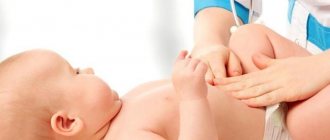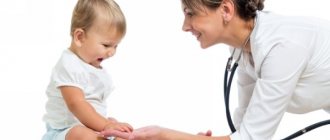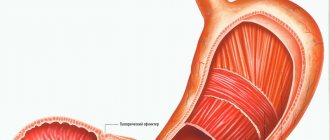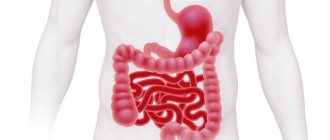Gastroesophageal reflux (GER) is the reverse movement of stomach contents through the esophageal valve back into the esophagus. The thesis “reflux” translated from Latin means reverse flow in comparison with natural movement. Gastroesophageal is literally translated from English as gastroesophageal reflux. GER can be a normal physiological or pathological indicator.
Physiological manifestation of GER
Gastroesophageal reflux is normal for children in the first year of life, due to the continued formation of the digestive system. During the process of regurgitation, trapped air and excess food are removed from the gastrointestinal tract, which do not saturate the body with nutrients. Excess food provokes fermentation and rotting processes, causing bloating and colic in the baby. Gastroesophageal reflux of a physiological nature protects the child’s body from overeating and pain.
| Age | Number of regurgitations per day | % ratio (out of 1000 children) |
| Children under 3 months | 1 − 4 | 50% |
| Children 4−6 months | 6 − 7 | 67% |
| Children 6 – 7 months | 1 − 3 | decreases from 61 to 21% |
| Children 8 – 12 months | 1 − 2 | 5% |
| Children 12 – 18 months | − | stops completely |
By the age of one year, the child’s digestive system is almost completely formed: mucous membrane, enzyme production, sphincter, however, the muscular layer of the gastrointestinal tract is poorly developed. By 12–18 months, the baby’s physiological manifestations of reflux completely cease, except for pathological abnormalities.
General recommendations and rules of behavior in the presence of disease
One of the rules that must be followed throughout life should be small meals, no overeating. The last meal should be no later than 3 hours before going to bed. If there is a disease, children should not be denied chewing gum; it increases the amount of saliva, which cleanses the esophagus of excess gastric juice.
In the 21st century, the problem of GERD has reached epidemic proportions, so at the slightest “hint” of pathology, you should consult a doctor and follow all recommendations in order to prevent surgical intervention and the development of cancer.
Diagnosis of pathology is made on the basis of clinical manifestations and laboratory results. When interviewing parents and the child, the doctor finds out the duration of symptoms, previous diseases, and the presence of predisposing factors. The main methods for diagnosing GERD include:
- endoscopic examination;
- biopsy of the esophageal mucosa;
- radiography using a contrast agent;
- daily pH study;
- manometric examination.
These examinations make it possible to determine the condition of the esophagus, the number of refluxes per day, detect ulcers, and evaluate the functionality of the valves. A biopsy is intended to promptly detect changes in the structure of the mucosa and prevent tumors.
The procedure for endoscopic examination of the stomach
Risk factors for the pathological development of GER
Gastroesophageal reflux, which is a consequence of pathological conditions in the gastrointestinal tract and does not go away for a long time, is diagnosed as gastroesophageal reflux disease (GERD).
Congenital anomalies associated with gastroesophageal reflux in children under 1 year of age are the result of:
- premature birth;
- suffered intrauterine oxygen deficiency of the fetus (hypoxia);
- suffocation of a newborn as a result of oxygen starvation and excessive accumulation of carbon dioxide in the blood and tissues (asphyxia);
- birth injury of the cervical spine;
- inflammatory processes in the gastrointestinal tract;
- pathological development of the esophagus;
- diseases of the upper digestive system at the genetic level, including GERD;
- improper lifestyle of the mother during pregnancy.
Gastroesophageal reflux disease is often an acquired pathological condition in children and occurs as a result of:
- lactose intolerance due to low levels of the enzyme lactase, which helps digest it;
- food allergies, mostly intolerance to cow's milk proteins;
- poor nutrition of the mother during lactation;
- early artificial feeding;
- long-term treatment with anti-inflammatory medications and drugs that include theophylline;
- improper diet;
- reduced immune system;
- infectious diseases caused by candida fungi, herpes, cytomegalovirus;
- diseases of the gastrointestinal tract: gastritis, peptic ulcers, stool disorders.
IMPORTANT! A common cause of acquired GER in a child is overfeeding, as a result of which excess stomach contents put pressure on the esophageal sphincter, disrupting its functionality in the future.
Reviews from specialists about gastroesophageal reflux in children. What can cause congenital and acquired pathology. Symptoms and preventive measures.
Gastroesophageal reflux in children: treatment
If gastroesophageal reflux disease is diagnosed, how to treat and what to do? If the reflux is uncomplicated, then the baby can be cured by simply changing the diet. To do this, doctors recommend taking the following measures:
- reduce food portions to prevent your baby from overeating;
- prevent children from coming into contact with tobacco smoke;
- remove milk from the diet;
- add various food thickeners to the menu.
These are four recommendations that will help the stomach process food faster without irritating the mucous membrane of the esophagus. Often parents do not understand how giving up milk can affect the development of reflux, because children under one year old are still breastfed.
The fact is that milk contains protein, which some children cannot digest. This condition is called dietary protein-induced gastroenteropathy.
Important ! Often this disease persists in children under one year of age, so nursing mothers need to stop consuming dairy and soy products. If milk protein intolerance persists after a year, then the diet should be extended. In this case, it is better to show the child to a doctor.
Food thickeners
These substances help make the consistency of food denser, so it is easier for the child to get full faster. Due to the thick consistency, food will not quickly flow from the stomach into the esophagus.
The following substances are used: corn, potato and rice starch, carob flour. American scientists have determined that no more than 1 tablespoon of thickener per 30 ml of liquid can be added to the food of a child aged 0 to 3 months.
You need to add a thickener to expressed breast milk in the same way, but you need to make a larger hole in the bottle to make it easier for the baby to suck on food.
The nuances of the baby’s body position at the time of feeding
To prevent liquid food from returning from the stomach to the esophagus, you need to feed the baby in an upright position. In addition, after eating, the baby should be carried in your arms so that the head rests on the parent’s shoulder. In this position, the child should be in a state of physical and emotional peace. You should not overfeed your baby, as his stomach is still small in volume.
Important ! As soon as the baby stubbornly begins to lose interest in food, you need to stop feeding.
If conservative treatment methods do not help, the doctor may prescribe medication. It is based on drugs that reduce the acidity of gastric juice.
There are four main principles of conservative treatment of this disease, namely:
- healthy and moderate diet (eat at least 5 times a day, do not eat 3 hours before bedtime, drink more water, reduce the consumption of sweet and fatty foods);
- reducing the production of gastric juice by taking adsorbents and antacids (“ Gaviscon ”);
- taking prokinetics that stimulate the motor-evacuation function of the stomach (“ Cerucal ”);
- prescription of drugs that reduce the negative effect of acid on the esophagus (“ Ranitidine ”, “ Fanitidine ”).
Not all of these drugs can always help a child, because sometimes they can cause side effects. It is contraindicated to give these medications to your child on your own.
Symptoms of GER in newborns
Determining the cause of GER in young children is quite difficult, because they cannot say what is bothering them and how exactly one can only guess from the symptoms and observations of the parents.
Symptoms of gastroesophageal reflux in children:
- frequent regurgitation;
- belching;
- vomiting of undigested food;
- hiccups;
- uncomfortable burning sensations in the stomach and esophagus;
- stool disorders;
- increased gas formation;
- weight loss;
- Constant crying and restlessness after eating.
In the early stages of development, GERD may be asymptomatic.
Recommendations from experts
There is no need to panic if your baby burps. In frequent cases, regurgitation is a normal physiological feature of the baby’s body. Only when the baby’s general health has deteriorated significantly (regurgitation is profuse and systematic) is it important to immediately go to the hospital or call an ambulance. Under such conditions, irreversible health problems may occur.
Self-medication is prohibited, since the child’s body is especially vulnerable to the effects of any medications. Delay can only provoke the development of complications and worsen the child’s well-being. It is forbidden to use any traditional methods of treatment, since various herbs and infusions can only aggravate the problem. During the process of excessive regurgitation, the baby’s body becomes dehydrated, which leads to the development of serious pathologies. To prevent this, it is important not to delay going to the pediatrician. The doctor will carry out a thorough diagnosis of the baby and prescribe a comprehensive treatment that will help get rid of the problem.
This article was co-authored by
Laura Marusinec, MD
. Dr. Marusinets is a board-certified pediatrician in Wisconsin. She graduated from the College of Medicine of Wisconsin Medical School in 1995.
Number of sources used in this article: 38. You will find a list of them at the bottom of the page.
In this Article:Lifestyle ChangesHealth Care38 Sources
Many newborns experience acid reflux, which is when food rises up from the stomach and the baby regurgitates it. Typically, acid reflux, or gastroesophageal reflux disease, is not dangerous and goes away by 18 months. However, parents are often nervous when their child suffers from this condition. Lifestyle changes and medical help can help your child cope with acid reflux.
Part 1 Lifestyle changes
Recognize the symptoms of acid reflux.
Before making any changes, monitor your child to see if he or she is experiencing acid reflux. The following symptoms indicate acid reflux in newborns:- Regurgitation of food and vomiting
Refusal to eat
- Difficulty eating and swallowing
- Irritation while eating
- Belching or hiccups with liquid discharge
- Lack of weight.
Change bottle feeding.
Try changing the way you bottle feed your baby. This may reduce or eliminate acid reflux in your newborn.- Increase feeding frequency, but reduce dose. This will help relieve pressure on the muscle that keeps food from moving up the esophagus.
Make sure the bottle and nipple are the right size. This is important so that the baby does not swallow air along with the milk.
- Try a different formula after first consulting with your pediatrician.
- As recommended by your pediatrician, add a little rice porridge to the milk formula.
Change the way you breastfeed.
Breastfeeding can help reduce reflux somewhat because breast milk is digested faster than formula.As with bottle feeding, try changing the method and see if your baby's reflux improves.
- Reduce the amount of milk your baby drinks at one time while increasing the number of feedings.
Try eliminating certain foods from your diet and see if your baby's reflux improves. For example, you can sequentially eliminate dairy products, beef, or eggs to see if reflux is caused by these foods.
- Add just a little rice porridge to the expressed breast milk.
Let your baby burp more often.
Interrupt feeding to allow baby to burp.Burping more frequently reduces pressure in the stomach and helps prevent reflux. To do this, adhere to the following regimen:
- Try not to feed your baby within two hours of bedtime.
Make sure your baby burps for 1-2 hours after feeding. This will prevent gas accumulation and reflux.
- When feeding, take breaks after every 30-60 milliliters of milk you drink.
- When breastfeeding, let your baby burp every time he comes off the breast.
Hold your baby upright.
This will help relieve or even prevent reflux due to the fact that under the influence of gravity the contents of the stomach drop down. After finishing feeding, hold the baby upright for 20-30 minutes.- Place your baby on your lap with his head resting on your chest.
Try to keep the baby calm while you hold him upright.
Move your baby into a sleeping position.
To reduce the risk of sudden infant death syndrome, doctors recommend that babies sleep on their backs.However, this position can cause problems in babies with moderate to severe reflux, so your pediatrician may recommend placing your baby on his or her side or stomach, although this is unlikely.
- Before changing your baby's sleeping position, be sure to consult your pediatrician.
Place your baby in the crib on a firm mattress without blankets, pads or stuffed animals that could cause suffocation. Gently turn your baby's head to the side so that nothing covers his mouth and nose.
- Consider raising the mattress slightly at the head of the mattress. Place a piece of foam or a wedge-shaped pillow under it. However, do not place a pillow on top of the mattress, as the baby may suffocate in it. If you raise the head of the bed, it will be easier for your child to sleep on his back, which is safest.
- Place the baby on the left side. In this case, the inlet of the stomach will be higher than the outlet, which will help avoid food rising.
Consider using natural remedies.
Pharmacies sell so-called “colic water” based on natural products, which helps alleviate reflux and stomach cramps. Although there is no scientifically proven evidence of its effectiveness, try giving this water to your child after first consulting with your pediatrician.- Please note that the World Health Organization does not recommend giving colic water to children under 6 months of age.
Before giving colic water to your baby, be sure to consult your pediatrician.
- Look for products with fennel, peppermint, lemon balm, chamomile or ginger.
- Do not use products with sodium bicarbonate, sucrose, fructose or alcohol.
Classification of GERD
Gastroesophageal reflux disease is divided into:
- form of flow;
- degree of expression;
- varieties.
Forms of gastroesophageal reflux disease
GERD is divided into 2 forms:
- acute , resulting from improper functionality of the gastrointestinal tract. With this form, the child is sore, lacks appetite, and weakness.
- chronic , which is a consequence of diseases of the digestive system. It can occur on its own due to poor nutrition.
Degrees of expression
According to the degree of development, gastroesophageal disease is divided into 4 stages:
- Stage 1 has mild symptoms or is asymptomatic. As the pathology develops, irritation, swelling and redness of the mucous membrane of the esophagus occurs, and tiny erosions from 0.1 to 2.9 mm appear.
- Stage 2 manifests itself in the form of heartburn, pain and heaviness after eating. Ulcers from 3 to 6 mm form in the esophagus, which affect the mucous membrane, causing discomfort to the child.
- The 3rd stage is manifested by severe symptoms: pain when swallowing, a regular burning sensation in the chest, a feeling of heaviness and pain in the stomach. Ulcers form a general lesion of the esophageal mucosa by 70%.
- The 4th stage is painful and dangerous to the health of the baby, which can degenerate into cancerous diseases. The esophagus is affected by more than 75% of the total mass. The child is constantly bothered by painful sensations.
Gastroesophageal disease is diagnosed in 90% of cases at the second stage, when symptoms become pronounced. The last stages of development can be cured with surgical intervention.
Types of GERD
Due to the occurrence of the disease, gastroesophageal disease is divided into types:
- catarrhal - during which the mucous membrane of the esophagus is damaged due to the ingress of acidic stomach contents;
- edematous - in the process the esophagus narrows, its walls thicken and the mucous membrane swells;
- exofoliative – which is a complex pathological process, as a result of which the high molecular weight protein fibrin is separated, which leads to hemorrhages, severe pain and cough;
- pseudomembranous - accompanied by nausea and vomiting, the mass of which contains filmy grayish-yellow fibrin components;
- ulcerative – the most complex form, occurring with ulcerative lesions and curable only by surgical intervention.
If your child has frequent and regular complaints, you should immediately consult a doctor.
Treatment
GERD is a disease that cannot be cured using traditional medicine alone. Pathology can cause serious consequences. Because of this, if signs of illness are detected in both newborns and older children, contacting a doctor should occur immediately.
Treatment of GERD in children depends on age and physiological characteristics. When feeding a baby, you need to use food thickeners. In this case, the baby should be in a “half-sitting” position. After the baby has eaten, he must be held in a “column” for 20–30 minutes. Feeding portions should be small. At the same time, the baby should be given food more often.
The child should sleep on his side, with the head of the bed raised. For older children, foods such as chocolate, spices, soda, fatty foods and fast food should be excluded from the menu.
In order to treat children, antacids, prokinetics, histamine receptor blockers, and proton pump inhibitors are used. Surgery is performed in cases where bleeding is observed due to perforation of the mucosa or if tissue scarring occurs too intensely.
To prevent the development of GERD, it is necessary to monitor the nutrition of children, regardless of their age. For older people, there are recommendations that include advice on healthy and fractional meals, moderate physical activity, and wearing loose clothing.
Complications after GERD
Since reflux symptoms may not appear immediately, it is quite difficult to prescribe timely treatment for your child. As a result of an advanced disease, complex pathological processes occur:
- burns of the esophageal mucosa with gastric contents;
- vitamin deficiency due to decreased appetite and lack of nutrients, loss of body weight;
- changes in the physiological shape of the esophagus, leading to chronic gastrointestinal diseases: ulcers, oncology;
- pneumonia and/or asthma resulting from the penetration of stomach contents into the respiratory tract;
- dental ailments, mainly damage to tooth enamel by hydrochloric acid.
Frequent hiccups or belching may indicate gastroesophageal reflux in a child. Not every pediatrician will be able to identify this disease. If such symptoms occur regularly, ask your pediatrician for a referral to a specialist - a gastroenterologist.
Degrees and forms
The forms of manifestation of pathology are also divided into clear groups.
Spicy. During the period of exacerbation of the disease, body temperature may rise, and pain may appear in the sternum area. Sometimes there are problems with swallowing, belching and excessive salivation.
Chronic. Complaints of constant heartburn, pain in the sternum, breathing problems may occur, and vomiting periodically appears.
Doctors also distinguish morphological forms:
- catarrhal - refers to the degree of the disease when the inflammation is localized on the mucous membrane and does not affect the surrounding tissues;
- the erosive form is characterized by lesions of the esophageal mucosa.
In pediatrics, there is a classification of the disease according to severity:
- the child may have gastroesophageal reflux without esophagitis;
- GERD with esophagitis. Childhood esophagitis has 4 degrees of severity: 1 degree, characterized by the appearance of erosions, but not in contact with each other;
- 2nd degree - existing erosions merge, but do not touch each other;
- 3rd degree - erosions merged together are localized in the lower part of the esophagus and can affect the entire surface of the stomach;
- 4th degree – chronic ulcer and stenosis of the esophagus;
Diagnostics
Diagnostic measures to detect GERD include:
- endoscopic examination method – helps to identify pathological inflammatory conditions in the esophagus from changes in the mucous membrane to hemorrhages;
- histological examination (biopsy) allows us to detect cellular changes in the epithelium as a result of the influence of previous diseases;
- manometric examination, which allows you to measure the pressure inside the esophageal lumen and evaluate the motor activity and functionality of both valves of the esophagus;
- a method for studying pH levels can determine the daily amount and duration of reflux;
- X-ray diagnostics helps to detect esophageal ulcers, narrowing of the lumen and hernia of the diaphragm.
Diagnosis of GERD can be prescribed both in a clinic and in a hospital.
Causes
The prerequisites for the development of GERD are not only a weakening of the antireflux mechanism, the reflux of acids (hydrochloric and bile) and pepsin into the esophagus, but also various anomalies that occur in childhood:
- Pyloric stenosis is a pathological narrowing of the pylorus of the stomach, which makes the movement of food difficult; accompanied by vomiting.
- Pylorospasm is a temporary contraction of the pylorus, which also delays the evacuation of food.
- Diaphragmatic hernia is a displacement of the lower esophagus into the chest cavity through the opening of the diaphragm.
Spitting up is not always harmless. The general condition of the child and the frequency of reflux manifestations will tell you when it is time to be examined to find the true cause of such conditions.











